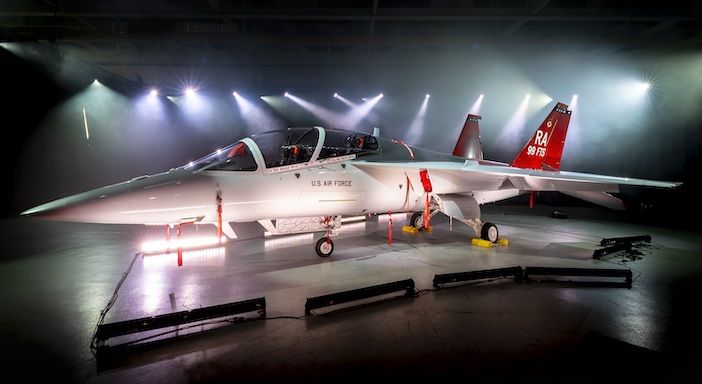The fuselage of the last Engineering and Manufacturing Development T-7A Red Hawk trainer jet has been assembled by Boeing at its St Louis factory in the USA.
Five Engineering and Manufacturing Development (EMD) jets are being built by Boeing and Saab for the T-7A development and test program.
Boeing has a US$9.2 billion contract to build 351 T-7A trainer jets for the US Air Force, 46 simulators and to provide support. The T-7A is replacing the T-38 Talon trainer jet, which was developed more than 60 years ago in the US Air Force fleet.
The T-7 is expected to enter service next year.
The rear section of the final EMD aircraft was delivered to Boeing from its partner Saab in Linköping, Sweden signaling the final EMD part delivery.
The forward and rear fuselages were then joined together in less than 30 minutes with the use of a digital process, 95% less time than a traditional aircraft would be spliced together, according to Boeing.
In the future, Saab plans to produce the rear sections at its manufacturing facility in West Lafayette, Indiana to reduce shipping times.
Paul Niewald, vice president of Boeing T-7 programs said, “We’re excited to begin building the first trainer jets future Air Force pilots will fly. Boeing and Saab quality and production teams will be closer, accelerating responsiveness to meet engineering and hardware needs.”
Jonas Hjelm, head of Saab’s Business Aeronautics said, “Developed with an engineering approach based on digital models, the T-7A represents a revolutionary approach to developing aircraft.”
The T-7 was developed using digital modeling and design techniques and went from concept to first flight in 36 months. The aircraft incorporates open architecture software, digital fly-by-wire controls and cockpit technology that provide improved levels of safety and training for future fighter pilots.
Related Stories
Boeing rolls out first production Red Hawk T-7A trainer jet
VR used to check T-7A Red Hawk trainer jet maintenance tasks





